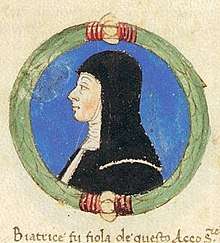Blessed Beatrice d'Este
Blessed Beatrice d'Este (Occitan: Biatritz or Beatritz d'Est) (1192 – 10 May 1264) was the daughter of Azzo VI of the Este family by his second wife, Sophia Eleanor, daughter of Humbert III, Count of Savoy. She was the aunt of Saint Beatrice d'Este.[1]

Life
An account of her life was written, in both medieval Latin and the Italian vernacular, by a Brother Alberto of the church of the Holy Spirit (S. Spirito). She was born at the Castello Estense, the seat of her family's power. About her youth Alberto wrote:
|
|
She became the object of the courtly love of Rambertino Buvalelli, a Bolognese troubadour who traveled widely in northern Italy. In nine of his cansos Rambertino celebrates the beauty and character of Beatrice, whom he frequently calls by the senhal (a "sign", as in a nickname) Mon Restaur ("My Refreshment" in Occitan). The large age difference between Rambertino and the young Beatrice probably amused the Estense court, although there was probably never an actual relationship between the two, their intercourse being purely poetic, lyric, and musical.
Beatrice became a Benedictine nun at Solarola near Padua at the age of fourteen, and in 1221 founded a religious house at the site of an abandoned monastery in Gemmola, formerly inhabited by hermits.[1] In the 17th century it was turned into villa by a Venetian merchant. Today the Villa Beatrice d'Este houses a nature museum.[2][3]
Sant'Antonio in Polesine
The name "in Polesine" does not refer to the area of Polesine, but to its original situation, high ground surrounded by water. The original monastery, founded in the early Middle Ages by Augustinians hermits, stood on an island in the middle of the Po River.[4]
Beatrice received the monastery from her father as a gift for her community. Around 1257, she moved into the convent, where she died in 1264.[5]
Her body was removed to Padua for burial in Santa Sofia. Subsequently her remains were returned to the cloister chapel of the Monastery of Sant'Antonio in Polesine which she founded. Her cultus was approved for Roman Catholics on 19 November 1763 by Pope Clement XIII and her feast is May 10.[1]
Notes
- Thurston, Herbert. "Beatrix." The Catholic Encyclopedia. Vol. 2. New York: Robert Appleton Company, 1907. 3 Aug. 2014
- Villa Beatrice d'Este Gemola Archived July 30, 2014, at the Wayback Machine
- Villa Beatrice d'Este
- "Monastery of Sant'antonio in Polesine", Emilia Romagna Turismo
- ""Convent of St. Anthony in Polesine", Siti Unesco del' Adriatico". Archived from the original on 2014-08-12. Retrieved 2014-08-04.